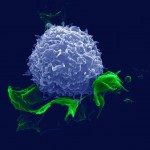Lien vers Pubmed [PMID] – 20665906
NMR Biomed 2010 Nov;23(9):1087-96
Signal loss observed in the brain by MRI following the administration of ultrasmall superparamagnetic particles of iron oxide (USPIO) has been correlated with immune cell activity in inflammatory areas during multiple sclerosis. Uptake of USPIO by circulating monocytes and their migration towards inflammatory areas have been considered as the most important mechanism for USPIO uptake by the brain parenchyma. However, the involvement of a damaged blood-brain barrier is also debated as a possible mechanism for cerebral USPIO uptake. Compared with these uptake-associated issues, little is known about the clearance of USPIO from the brain. The acute uptake and chronic clearance of USPIO in the brain were therefore studied with MRI in an animal model of multiple sclerosis. Lewis Hannover rats with acute experimental autoimmune encephalomyelitis received a single intravenous injection of USPIO (300 µmol Fe/kg), and repetitive MRI of the brain and cervical lymph nodes, a possible drainage pathway, was performed. USPIO were detected in the brain within 1 h after injection independent of the severity of experimental autoimmune encephalomyelitis, and histological analysis revealed extracellular iron clusters colocalising with a leaky blood-brain barrier. Loss of signal was not present 72 h after USPIO injection, irrespective of the disease state. MR images of cervical lymph nodes showed USPIO accumulation at 24 h after administration, which stabilised at 72 h. Histological analyses revealed that USPIO accumulated in infiltrated macrophages in the medulla and subcapsular sinus. The current study demonstrates that USPIO enter the central nervous system directly after administration, pointing to the involvement of a damaged blood-brain barrier in the appearance of USPIO-associated MR abnormalities. Furthermore, a possible role of the cervical lymph nodes as a drainage pathway of USPIO is suggested. These data shed new light on the use of USPIO in neuroinflammatory diseases, identifying USPIO as a marker for both cellular infiltration and blood-brain barrier damage.

